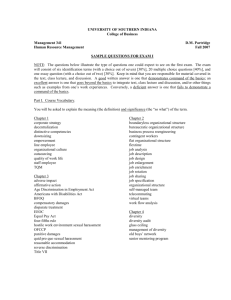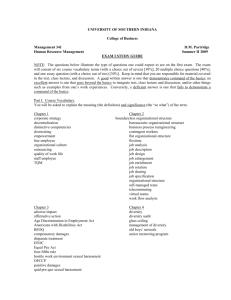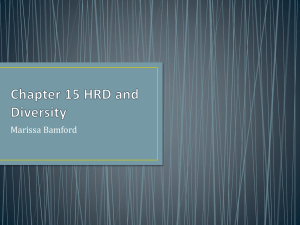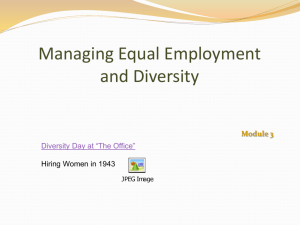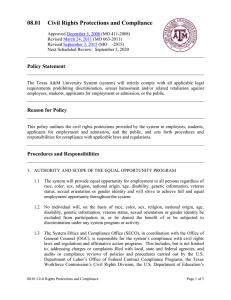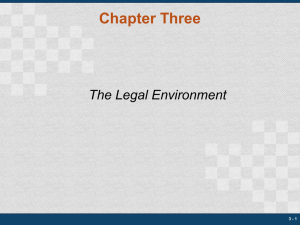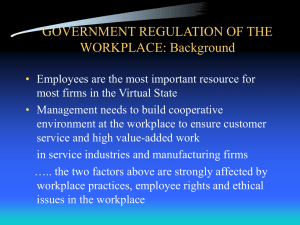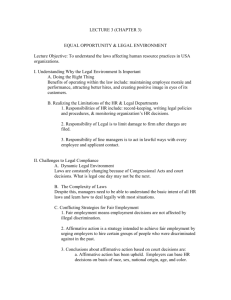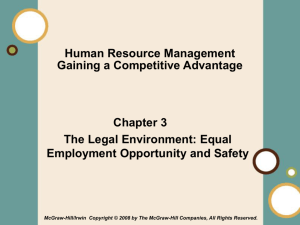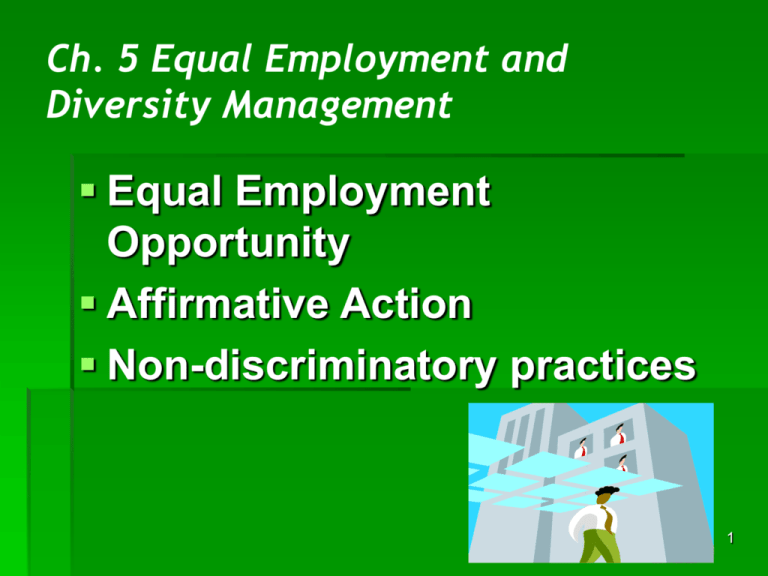
Ch. 5 Equal Employment and
Diversity Management
Equal Employment
Opportunity
Affirmative Action
Non-discriminatory practices
1
Race, National Origin, and
Citizenship Issues
Potential HR Issues
Racial/Ethnic
Discrimination
and Harassment
English-Only
Requirements and
Bilingual
Employees
Requirements
for Immigrants
and ForeignBorn Workers
2
2006 Charge Statistics from EEOC
Note: Because individuals often file charges claiming multiple types of
discrimination, the total percentages may exceed 100%. Total charges = 75,428.
Source: U.S. Equal Employment Opportunity Commission, 2006, www.eeoc.gov/stats/charges.html.
3
Sex/Gender Issues
Avoiding Pay Inequity:
Include benefits and other items of remuneration
to calculate pay
Inform employees of pay practices
Base pay on the value of performance and jobrelated factors
Benchmark pay against local and national
markets
Conduct internal audits to detect gender-based
inequities and ensure that pay is fair.
4
Female Annual Earnings as Percentage of Male Earnings
5
Source: U.S. Department of Labor, Bureau of Labor Statistics, 2006, www.bls.gov.
Women as Percentage of Total
Employees by Selected Industries
6
Source: U.S. Bureau of Labor Statistics, “Employed Persons by Detailed Industry and Sex,” 2006, www.bls.gov.
Sex/Gender Issues
Women in the workforce
Nontraditional jobs
Glass ceilings, walls and elevators
Nepotism
Communication
7
Sex/Gender Issues:
Breaking the Glass
Alternative work arrangements
Organizational diversity goals
Mentoring
Increase top management
diversity
8
Sex/Gender Issues
Sexual Orientation
Courts and EEOC have ruled that
sex discrimination under CRA Title
VII applies to a person’s gender at
birth.
Claims include hiring, firing,
promotion processes
9
Sexual Harassment and
Workplace Relationships
Consensual
Relationships and
Romance at Work
Workplace romances
are risky
Policies prohibiting
them are up
substantially
10
Types of Sexual
Harassment
Quid Pro Quo
Hostile Environment
Linking employment
outcomes to the
harassed individual’s
granting of sexual
favors.
Allowing intimidating or
offensive working
conditions
to unreasonably affect an
individual’s performance
or psychological wellbeing.
11
Potential Sexual Harassers
Supervisors
Coworkers
Other employees
Former employees
Customers
Vendors
12
Addressing the Issue of
Sexual Harassment
Sexual harassment policy
Communicated
Consistently enforced
Training for awareness, behavior
changes
Enabling complaints
Taking them seriously
Taking action
13
Sexual
Harassment
Liability
Determination
14
Source: Virginia Collins, PhD, SPHR, and Robert L. Mathis, PhD, SPHR, Omaha, Nebraska.
Age Issues and EEO
Discrimination against older
“overqualified” workers
Age discrimination in workforce
reductions
Attracting, retaining, managing older
workers (protected class)
15
HR
Managers’
Views of
Older
Workers
Consequences
• Health care usage
• Heath care costs
• More
training/retraining
• Employee stress
Older
Workers
Advantages
• Will work different
schedules
• Serve as mentors
• Have invaluable experience
• Have a strong work ethic
• Are more reliable
Disadvantages
• Are weak on new
technology
• Cause expenses to rise
• Are less flexible
16
Disabled Workers and
Applicants
Recruiting and selecting individuals
with disability
New disabilities
Mental disabilities
Life-threatening illnesses
17
Common Means of Reasonable
Accommodation
Modified work schedules
Special equipment
Job redesign
Reassignment
Employer-provided assistance
18
Religion and Spirituality in Workplaces
19
Affirmative Action
Affirmative Action
Employers urged to hire from protected classes to
make up for historical discrimination.
Affirmative Action and the Courts
Courts have upheld AA, but recently have limited it
somewhat.
Reverse Discrimination
Occurs when a person is denied an opportunity
because of preferences given to protected-class
individuals who may be less qualified.
20
Debate on Affirmative Action
Affirmative Action
Is Still Needed
• To overcome and eliminate the
effects of past injustices.
• To create equality for all
persons, even if temporary
injustice to some individuals
may result.
• Employment of protected-class
members will benefit society.
• Properly used, does not
discriminate against males or
whites.
• Goals indicate progress needed,
not quotas.
Affirmative Action Is
No Longer Needed
• Penalizes individuals even
though they have not been
guilty of discrimination.
• Creates preferences that result
in reverse discrimination.
• Results in greater polarization
and separatism.
• Stigmatizes those it is designed
to help.
• Forces employers to “play by
the numbers” as goals become
quotas.
21
Affirmative Action Plan (AAP)
Federal government contractors with more
than 50 employees and over $50,000 in
government contracts annually
Required to document the inclusion of
women and racial minorities in the
workforce.
Covered employers must submit plans to
narrow gap between the composition of
workforce and composition of labor
markets where they obtain employees.
22
Components
of an
Affirmative
Action Plan
(AAP)
23
Managing Diversity:
Tangible Indicators
Age
Marital and family status
Disability
Race/ethnicity
Religion
Gender
Sexual Orientation
24
Managing Diversity
Diversity: The Business Case
• Allows new talent and new ideas
from employees of different
backgrounds.
• Helps recruiting and retention.
• Allows for an increase in market
share.
• Leads to lower costs because
there may be fewer lawsuits.
25
Approaches to Diversity and Their Results
26
Common
Diversity
Management
Components
27
Diversity Training
Backlash Against Diversity
Efforts
Protected Groups
Non-Protected Groups
View diversity efforts as
inadequate and nothing
more than “corporate
public relations” that do
not meet expectations.
Believe that the emphasis
on diversity makes them
scapegoats for problems
created by increasing
diversity.
28

